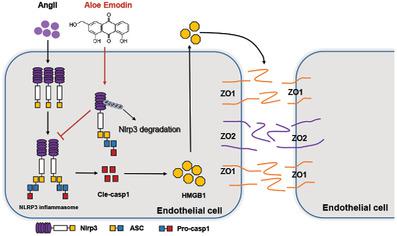当前位置:
X-MOL 学术
›
J. Leukoc. Biol.
›
论文详情
Our official English website, www.x-mol.net, welcomes your
feedback! (Note: you will need to create a separate account there.)
Aloe emodin relieves Ang II-induced endothelial junction dysfunction via promoting ubiquitination mediated NLRP3 inflammasome inactivation.
Journal of Leukocyte Biology ( IF 3.6 ) Pub Date : 2020-06-23 , DOI: 10.1002/jlb.3ma0520-582r Yi Zhang 1 , Ziqing Song 1 , Shan Huang 2 , Li Zhu 1 , Tianyi Liu 1 , Hongyan Shu 1 , Lei Wang 1 , Yi Huang 2 , Yang Chen 1
Journal of Leukocyte Biology ( IF 3.6 ) Pub Date : 2020-06-23 , DOI: 10.1002/jlb.3ma0520-582r Yi Zhang 1 , Ziqing Song 1 , Shan Huang 2 , Li Zhu 1 , Tianyi Liu 1 , Hongyan Shu 1 , Lei Wang 1 , Yi Huang 2 , Yang Chen 1
Affiliation

|
Recent studies have revealed that aloe emodin (AE), a natural compound from the root and rhizome of Rheum palmatum L., exhibits significant pharmacologic activities. However, the pharmacologic relevance of the compound, particularly for cardiovascular disease, remains largely unknown. Here, we hypothesized that AE could improve endothelial junction dysfunction through inhibiting the activation of NOD‐like receptor family pyrin domain containing‐3 (NLRP3) inflammasome regulated by NLRP3 ubiquitination, and ultimately prevent cardiovascular disease. In vivo, we used confocal microscopy to study the expression of tight junction proteins zonula occludens‐1/2 (ZO‐1/2) and the formation of NLRP3 inflammasome in coronary arteries of hypertension. And the experimental serum was used to detect the activation of NLRP3 inflammasome by ELISA assay. We found that AE could restore the expression of the endothelial connective proteins ZO‐1/2 and decrease the release of high mobility group box1 (HMGB1), and also inhibited the formation and activation of NLRP3 inflammasome. Similarly, in vitro, our findings demonstrated that AE could restore the expression of the tight junction proteins ZO‐1/2 and decrease monolayer cell permeability that related to endothelial function after stimulation by angiotensin II (Ang II) in microvascular endothelial cells (MECs). We also demonstrated that AE could inhibit Ang II‐induced NLRP3 inflammasome formation and activation, which were regulated by NLRP3 ubiquitination in MECs, as shown by fluorescence confocal microscopy and Western blot. Together with these changes, we revealed a new protection mechanism of AE that inhibited NLRP3 inflammasome activation and decreased the release of HMGB1 by promoting NLRP3 ubiquitination. Our findings implicated that AE exhibited immense potential and specific therapeutic value in hypertension‐related cardiovascular disease in the early stage and the development of innovative drugs.
中文翻译:

芦荟大黄素通过促进泛素介导的NLRP3炎性体失活来缓解Ang II诱导的内皮连接功能障碍。
最近的研究表明,芦荟大黄素(AE)是一种来自大黄的根和根茎的天然化合物。L.,表现出明显的药理活性。然而,该化合物的药理学相关性,尤其是对心血管疾病的药理学相关性仍然未知。在这里,我们假设AE可以通过抑制由NLRP3泛素化调节的NOD样受体家族含3(NLRP3)炎症小体的活化来改善内皮连接功能障碍,并最终预防心血管疾病。在体内,我们使用共聚焦显微镜研究了高血压冠状动脉中紧密连接蛋白zonula occludens-1 / 2(ZO-1 / 2)的表达和NLRP3炎性小体的形成。并用ELISA法检测血清对NLRP3炎性小体的活化作用。我们发现AE可以恢复内皮连接蛋白ZO‐1 / 2的表达并减少高迁移率基团box1(HMGB1)的释放,并抑制NLRP3炎性小体的形成和激活。同样,在体外,我们的研究结果表明,在血管紧张素II(Ang II)刺激微血管内皮细胞(MEC)后,AE可以恢复紧密连接蛋白ZO-1 / 2的表达并降低与内皮功能相关的单层细胞通透性。我们还证明了AE可以抑制Ang II诱导的NLRP3炎性小体的形成和激活,这由MEC中的NLRP3泛素化调节,如荧光共聚焦显微镜和Western印迹所示。连同这些变化,我们揭示了一种新的AE保护机制,该机制通过促进NLRP3泛素化来抑制NLRP3炎性体激活并减少HMGB1的释放。我们的发现暗示,AE在早期和开发新药的过程中,在高血压相关的心血管疾病中显示出巨大的潜力和特定的治疗价值。
更新日期:2020-06-23
中文翻译:

芦荟大黄素通过促进泛素介导的NLRP3炎性体失活来缓解Ang II诱导的内皮连接功能障碍。
最近的研究表明,芦荟大黄素(AE)是一种来自大黄的根和根茎的天然化合物。L.,表现出明显的药理活性。然而,该化合物的药理学相关性,尤其是对心血管疾病的药理学相关性仍然未知。在这里,我们假设AE可以通过抑制由NLRP3泛素化调节的NOD样受体家族含3(NLRP3)炎症小体的活化来改善内皮连接功能障碍,并最终预防心血管疾病。在体内,我们使用共聚焦显微镜研究了高血压冠状动脉中紧密连接蛋白zonula occludens-1 / 2(ZO-1 / 2)的表达和NLRP3炎性小体的形成。并用ELISA法检测血清对NLRP3炎性小体的活化作用。我们发现AE可以恢复内皮连接蛋白ZO‐1 / 2的表达并减少高迁移率基团box1(HMGB1)的释放,并抑制NLRP3炎性小体的形成和激活。同样,在体外,我们的研究结果表明,在血管紧张素II(Ang II)刺激微血管内皮细胞(MEC)后,AE可以恢复紧密连接蛋白ZO-1 / 2的表达并降低与内皮功能相关的单层细胞通透性。我们还证明了AE可以抑制Ang II诱导的NLRP3炎性小体的形成和激活,这由MEC中的NLRP3泛素化调节,如荧光共聚焦显微镜和Western印迹所示。连同这些变化,我们揭示了一种新的AE保护机制,该机制通过促进NLRP3泛素化来抑制NLRP3炎性体激活并减少HMGB1的释放。我们的发现暗示,AE在早期和开发新药的过程中,在高血压相关的心血管疾病中显示出巨大的潜力和特定的治疗价值。









































 京公网安备 11010802027423号
京公网安备 11010802027423号